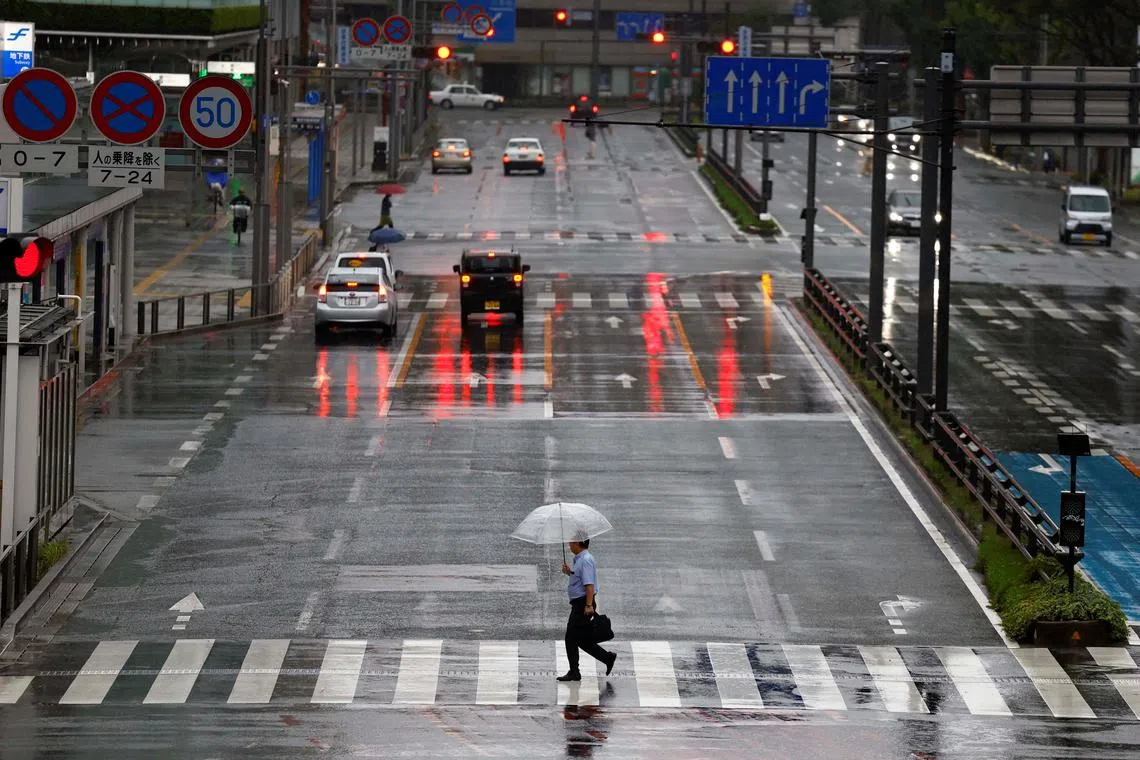Typhoon Shanshan drenches Japan, prompting landslide and flood alerts
Sign up now: Get ST's newsletters delivered to your inbox

People with umbrellas walking through the rain and wind caused by Typhoon Shanshan in Fukuoka, Japan, on Aug 30.
PHOTO: REUTERS
Follow topic:
FUKUOKA – Typhoon Shanshan soaked large swathes of Japan with torrential rain on Aug 30, with warnings for flooding and landslides hundreds of kilometres from the storm’s centre, halting travel services and shutting production at major factories.
At least four people have been killed and 99 injured in storm-related incidents in recent days, according to the disaster management agency.
In the south-western region of Kyushu, where the authorities say one of the strongest storms ever to hit the region made landfall on Aug 29, residents were surveying the damage after a night of heavy rain and severe winds.
Madam Yu Fukuda, 67, who runs a fish farm and adjoining restaurant in the resort town of Yufu in Oita prefecture, said she arrived on the morning of Aug 30 to find flood waters 1m high had inundated the building.
“There were streaks on the windows and everywhere there were marks from mud and dirt, so I could tell how high the water had risen. I felt very sad,” she told Reuters as her staff and relatives cleared the debris of fishing nets and dead fish.
“I wish the typhoon had just passed quickly, but it stayed around here for a long time,” she added.
Bringing gusts of up to 180kmh, strong enough to blow over moving trucks, the typhoon was near the coastal city of Matsuyama in Ehime prefecture at 3.45pm (2.45pm Singapore time) and moving east, according to the authorities.
Around 250,000 households in seven prefectures were without power in Kyushu on Aug 29, according to Kyushu Electric Power, but many had seen services restored on Aug 30.
The warm and moist air flowing around the typhoon brought record-breaking levels of rain in some areas far from the main storm, which the authorities say is concerning given its slower-than-expected movement across the country.
Notices advising residents to evacuate have been issued to more than 3.3 million people nationwide, mostly in the hard-hit Kyushu area and central and eastern regions, including the capital Tokyo and nearby Yokohama.
The authorities there warned of possible landslides and rivers bursting their banks due to the heavy rain.
Shizuoka, a major city in central Japan, has seen more than 500mm of rain in the last 72 hours, the highest volume since the weather agency began collecting the data in 1976.
But, as at Aug 29, only about 30,000 had been evacuated, mainly in Kyushu, Disaster Management Minister Yoshifumi Matsumura said.
The storm is expected to approach the central and eastern regions, which includes Tokyo, at the weekend and into early next week, the weather agency said.
Toyota has suspended operations in all of its domestic plants to the morning of Sept 2 due to the storm. Other automakers, Nissan and Honda, semiconductor firms Renesas and Tokyo Electron, and electronics giant Sony have also temporarily halted production at some factories.
Airlines, including ANA Holdings and Japan Airlines, have announced cancellations of hundreds of domestic and some international flights.
Many ferry and rail services, including the bullet train between Tokyo and the central city of Nagoya, were suspended on the morning of Aug 30.

A man reading a notice about subway service suspension due to Typhoon Shanshan in front of the rail pass gate at Hakata station, Fukuoka, Japan, on Aug 30.
PHOTO: REUTERS
Ms Lin Yue-Hua, a 60-year-old tourist from Taiwan, had her flight from Fukuoka back home cancelled on Aug 29. She was told to book another flight but was struggling to make her way to the airport on the morning of Aug 30.
“We were very worried and upset because we didn’t know what to do,” she told Reuters at a near-deserted train station after finding out that all rail services, including the subway to the airport, had been cancelled.
“We stayed one more day in Japan. Then we saw in the news that our flight from Taiwan could not land in Japan after flying around the area for about 40 minutes, and it flew back to Taiwan. So we have been busy trying to find our way home.”
Typhoon Shanshan is the latest harsh weather system to hit Japan, following Typhoon Ampil, which also led to blackouts and evacuations, earlier in August. REUTERS

